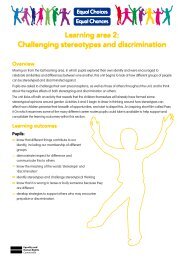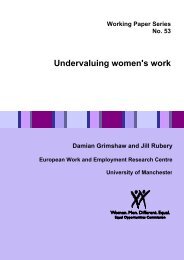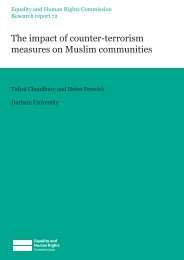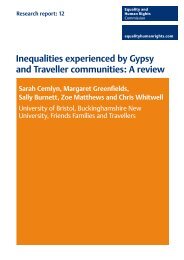Chapter 10: Education - Equality and Human Rights Commission
Chapter 10: Education - Equality and Human Rights Commission
Chapter 10: Education - Equality and Human Rights Commission
You also want an ePaper? Increase the reach of your titles
YUMPU automatically turns print PDFs into web optimized ePapers that Google loves.
300<br />
<strong>Chapter</strong> <strong>10</strong>: <strong>Education</strong><br />
Summary<br />
A wealth of evidence shows that education is a key determinant of life chances.<br />
As well as being a right in itself, education is an enabling right, allowing<br />
individuals to develop the skills, capacity <strong>and</strong> confidence to secure other rights <strong>and</strong><br />
economic opportunities.<br />
<strong>Education</strong>al attainment has been transformed in recent years. Around half<br />
of young people are now getting good qualifications at 16 (5+ A*-C GCSEs or<br />
equivalent including English <strong>and</strong> Maths), <strong>and</strong> in 2008/09, 2.4 million students<br />
enrolled in higher education in the UK – a considerable change from a time when<br />
educational opportunities were only available to a minority of young people. The<br />
indicators examined in this chapter demonstrate this success, but also show that<br />
there remain a number of areas where further progress needs to be made.<br />
<strong>Chapter</strong> <strong>10</strong><br />
The evidence from these indicators shows that educational attainment continues<br />
to be strongly associated with socio-economic background, despite some signs<br />
that social differences in examination results may have started to reduce. At the<br />
same time, the gap in attainment between ethnic groups has narrowed more<br />
clearly, with some previously low-performing groups catching up with the average.<br />
Whereas a generation ago almost all the students on the university campus were<br />
White British, today 1 in 5 are from ethnic minority groups <strong>and</strong> an increasing<br />
number of disabled students are also attending. Women are now ahead of men in<br />
many aspects of educational success.<br />
However, in terms of both subjects studied, <strong>and</strong> in the obtaining of good degrees,<br />
differences persist. Women remain less likely than men to study Science,<br />
Technology, Engineering <strong>and</strong> Maths (STEM) subjects, making up 48% of first<br />
degree students in STEM despite comprising 55% of first degree students overall.<br />
Gender differences in first degree subject choice appear to be declining over<br />
time, but extremely high gender segregation in vocational training remains. The<br />
proportion of Black students getting first or upper second class degrees is still only<br />
at two-thirds of the level of White students.<br />
This chapter also notes that some groups are still not getting a fair deal out of the<br />
education system. Young people with Special <strong>Education</strong>al Needs (SEN) account<br />
for 7 in <strong>10</strong> permanent exclusions from school in Engl<strong>and</strong>, <strong>and</strong> continue to have<br />
low educational attainment. A growing number of disabled students are going to<br />
university, but this group is still not achieving its potential. Calls to helpline related<br />
to disability <strong>and</strong> education also indicate that this is an area of concern.<br />
For lesbian, gay <strong>and</strong> bisexual (LGB) <strong>and</strong> transgender young people, attainment<br />
trends are harder to measure, but there are signs that they are being penalised<br />
by unfair treatment <strong>and</strong> bullying in the education system, at school <strong>and</strong> beyond.












